
We open our page at a landmark moment in the cycling history book, on 19th April 1960, as the giant Tube Investments Group agrees terms for the takeover of Raleigh Cycles.
Things will never be the same...
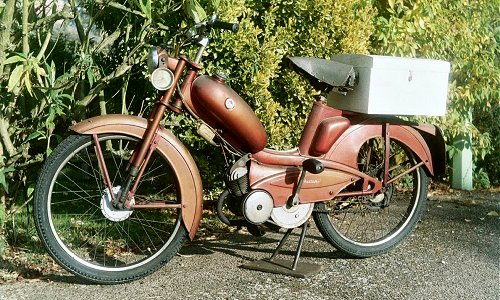
From this date, a cold wind of change will start to blow through all the companies of the British Cycle Corporation.
In October 1960, Raleigh de-listed its Sturmey-Archer powered RM2C moped and announced a completely new range of mopeds to be made under licence from the French Motobécane company.
The official launch of these machines took place at Alexandra Palace, just before the Earls Court Show in November. Also launched at this time, Raleigh announced the 78cc Roma scooter, made under licence from Bianchi.
Assembled at Nottingham, the new Raleigh RM4 Automatic moped appeared in trade listings from February 1961, in preparation for the forthcoming sales season.
Though Motobécane components comprised the main elements of the bike, there were a number of cycle fittings that distinguished the machine from the French company's own models. Most distinctive was the Lido petrol tank adopted from Norman, which so suitably mounted on the forward frame tube that anyone could have been forgiven for thinking this may have been designed for the machine. Not so, the component was descended from the Achilles company in Germany, when they introduced it on their original Lido in October 1956.
The saddle stem tube of Motobécane's frame is wrapped in by Raleigh's own pressed steel fairing (which Raleigh rather vaguely called a 'carrier assembly'), with toolboxes both sides and topped by a sturdy press formed rack.
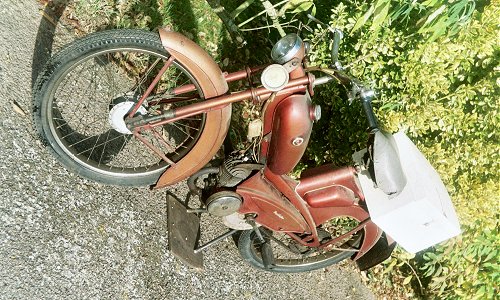
The RM4 wheels were laced at Nottingham with Dunlop Endrick pattern 19-inch rims. A Lucas L590 light unit was mounted atop the Raleigh pattern rear number plate.
In April 1961 the forthcoming cessation of Norman at Ashford was announced and, by 30th August 1961, though Charles and Fred Norman retired as the Ashford factory doors closed for the last time, just the following month found the surprising announcement of a new Nippy Mark 5 moped! This latest Norman model was, however, no more than another derivative of the Raleigh RM4 and was accompanied by the introduction of a new Phillips-badged Panda Mark 3 at the same time. Built on the Raleigh assembly line at Lenton Boulevard in Nottingham, the Norman and Phillips names had become no more than group-assembled, market-branded products.
The £62-17-1d Raleigh RM4 was pitched as top dog in this family of badge-engineered models, with its two-tone paintwork in dark grey & cream, 'Super-Comfort' saddle, shrouded fork legs and integral speedo in the Luxor headlamp. The Norman Nippy Mark 5 at £60-0s-0d filled the middle ground, also with two-tone scheme in dark grey & ice blue, also with the Super-Comfort saddle and shrouded fork legs, but with plain Lucas headlamp. Phillips found itself relegated to economy brand, priced at £59-0s-0d, with an archaic Wrights S.65/3 'tension coil sprung' saddle, bare fork legs, plain Lucas headlamp, and mono-colour paint in sparkling Royal Carmine Red. The public took well to the striking metallic paintwork and lower price tag, so the Phillips Panda actually sold very well.
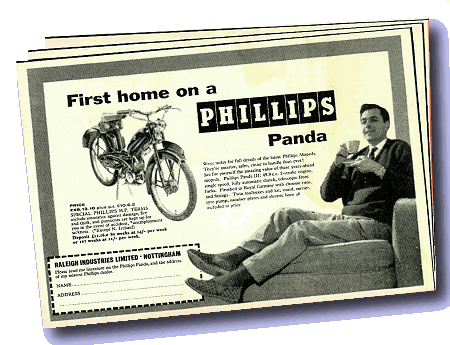
Half-page adverts in Reveille,
Weekend and Titbits
contributed to the popular success of the Panda
Our epic Pandamonium feature of January 2009 included a test of this original 1.4bhp Mark 3 (frame serial 1P2347), which was built for the next 17 months.
On 1st April 1963, Raleigh Service Memoranda No 7, advised dealers about the introduction of a new 1.7bhp Motobécane motor for the Panda Mark 3, effective from frame number 1P4679. Right at the very end of production, the Phillips brand had played its final card, and this represented the last official modification of the last Phillips moped. The Panda Mark 3 model was formally discontinued at the end of 1963 and failed to reappear in listings for 1964, though the trade still had had a number of leftover machines to sell the following year ... which is where our story now starts!
Our creature for this feature is one of these very last Panda Mark 3s, frame number 1P5183, and registered on 8th September 1964. This is a particularly appealing subject, being a very genuine one-owner machine right up to the time of its last use at MoT expiry on May 10th 1977.
Languishing in storage from this date, it never got recorded with DVLA until, supported by the old buff log book, its original serial was reclaimed 33 years later! The bike's original and unrestored appearance today is a testament to its own individual history, and bizarre in that the right side remains in the original Royal Carmine deep red colour, while the left side has sun-bleached to very closely resemble the classic Mobylette bronze finish! The effect is a striking fascination for comment and conjecture by everyone that sees it.
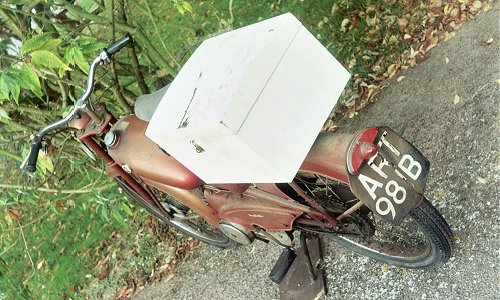
The stoutly constructed and functional wooden back-box is still retained as another period example from the bygone age of DIY carpentry, and though as aerodynamic and subtle as an albino aircraft hanger, it still seems to imbue some lost charm of the time. Even the temptation to clean the decades of accumulated dust has been resisted, so it beautifully conveys the whole 'barn find' image.
Being so untampered with, it really is a fine example of the closing product, and varies only from our previous Pandamonium test machine, with its 1.7bhp engine and a different fitted saddle.
The initial Wrights S.65/3 'tension coil sprung' saddle has been superseded by a compression sprung saddle that would appear to have been equally as uncomfortable since the seat top has been removed at some time, to stuff some additional foam between the cover and the springs.
Specification of the later engine only differs from the earlier motor as a higher compression ratio from 1cc less in the combustion chamber giving 7½:1 against the original 6½:1, and a larger exhaust port (20mm × 9mm) of the 'split-fin' cylinder, in comparison to 'continuous-fin' (20mm × 7mm). The transfer ports of both cylinders are still 18mm × 6mm, and both engines still mount the same BA10mm carburettor. These factors alone account for the whole 20%+ power increase, 1.4bhp to 1.7bhp, rated at 4,500rpm.
So when we get the last Panda out on the road, what will this equate to?
Fuel on, thumb the trigger choke to the left lever mount, forward decompress with the Amal twistgrip, then roll back the throttle as the engine spins, and the motor fires up easily on the very first attempt. The bike may look old and weathered but proves that looks can be deceiving.
The higher compression ratio provides appreciably better take-off from the un-assisted engine, though a little boost on the pedals still helps a standstill getaway. Acceleration is also noticeably improved, and built to a happy cruising speed up to 27mph, above which things started getting a bit buzzy, and obtrusive vibrations began to creep through the saddle. This time however, our Panda was untroubled by the four-stroking curse of the earlier engine and consistently ran along without the irritating grumble that afflicted its smaller ported predecessor. The better breathing also raised the rev ceiling, allowing the pace bike to clock us up to a best of 31mph on the flat (28 proved the limit of the earlier motor).
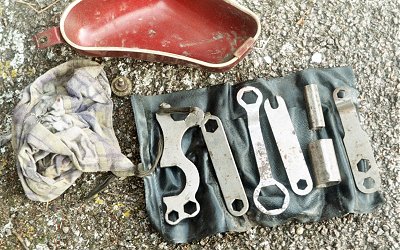
Halfway round our test circuit, our mount starts coughing and popping with all the signs of a whiskered spark plug, so we pull over to investigate whether the toolboxes might contain a plug spanner to address the matter. Surprisingly, we discover the bike still has its complete and original service toolset, still rolled in the genuine factory bag! Suitably de-whiskered, our ride resumes.
The downhill run paced a maximum of 35mph (33 was the best the first model could manage), and our 1.7bhp motor more readily achieved these higher revs with appreciably less complaint. Charging the climb on the other side, the engine powered confidently up the incline, never falling below 21mph to crest the rise, and clearly demonstrating the benefits of its higher compression ratio on this challenge.
The Lucas headlamp shell is still stamped with P, O, M and D switch positions, representing Off, Main and Dip functions, and the obsolete Park position in a throwback to the days of the old dry-cell battery assisted lighting sets on the preceding RM1 and RM2 models, from which the system was inherited.
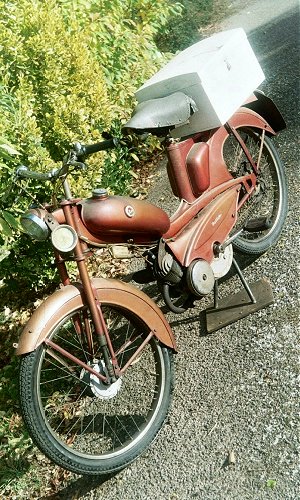
The Panda has no battery pack, and no park bulb is fitted in the lower headlamp socket. We tried the lamps, and from its well-preserved reflector, the 4-inch Lucas 15/15Watt headlight seemed to generate a nearly white light that, considering the limited performance, looked as if it might just be adequate to navigate by at night. We didn't actually try it down the dark country lanes however - no sense in tempting fate!
As always on these models, the 90mm front and 100mm rear Prior full width aluminium hub brakes both proved very capable of all stopping requirements.
Maybe the additional foam inserted under the cover improved the ride a little, though by no means any comparison with the luxury of the Raleigh Super Comfort Saddle, the seat did impart slightly less discomfort than the Wrights S.65/3.
Though still classed as a basic commuter moped, the last 1.7bhp Panda did represent a real improvement in performance of the model. All its Rex and Moby engined predecessors were afflicted with irritating bouts of four-stroke phasing at revs, and only these very last examples relieved the Panda rider's frustrations - but all too late, Phillips-branded mopeds had already been swept away in the closing months of 1963, before the last bikes were finally sold off in the following year.
Earlier introduction of the new Raleigh RM6 Runabout foretold the future in May 1963. Raleigh's RM4 officially continued until February 1964, though actually represented little more than a listing extension to clear remaining stocks. The RM4 'Automatic' had effectively been replaced by introduction of the RM8 in December 1963, so its production was almost certainly concluded at much the same time as Norman Nippy Mark 5 and Phillips Panda Mark 3 derivatives. With deletion of the Gadabout Mark 4 and Panda Mark 3 models, Phillips branded motorised products officially ended in 1963, but fate had one final card to play...
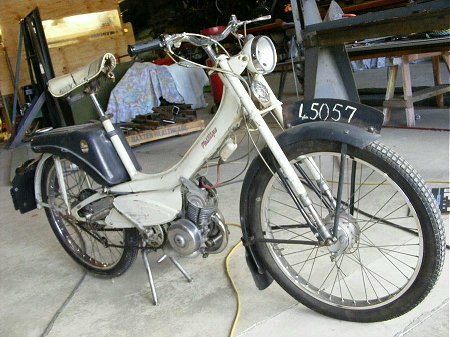
With its export efforts over the years, Phillips had become a familiar brand in a number of British colonies across the world, and particularly established its name across the far side of the world - in New Zealand. Earlier sales of cycles and mopeds under the auspices of the British Cycle Corporation had established recognition of the Phillips badge with a loyal dealer and customer network - while Raleigh had no practical background in this market.
When New Zealand distributors came to ordering new machines for their summer sales season, October 1964 to March 1965, they weren't interested in Raleigh branded models that their customers didn't know - they wanted to sell Phillips badged mopeds their customers would be familiar with and could relate to!
So, to secure the order, Raleigh created a special export RM8 Runabout just for New Zealand, and branded this special version the Phillips Traveller.
Traveller frames are still identified with Raleigh's 8R prefix to the serial, finished in white (what Raleigh described as Pearl Grey), with a unique dark grey trim, standardly equipped with Lucas headlamp (no home trade Runabout ever had this fitting), badged with 'Phillips' transfers on the frame and petrol tank, and 'Traveller' decals on the side panels.
1965 registered Phillips Travellers are recorded in New Zealand, though whether any subsequent export batches were produced is not currently established. The Raleigh RM8 was listed until September 1969 in the UK.
Next - "There he is look, Ifor the Engine. Just an ordinary looking steam engine. You'd never think to look at him; he's got a dragon in his firebox!" In the stories of Oliver Postgate, Idris Bach was a small, heraldic Welsh red dragon, hatched from an egg in the firebox of Ifor the Engine. Our red dragon is however, a small Welsh motor cycle, and this is our tale of Idris.
[Text and photos © 2011 M Daniels. Period documents from IceniCAM Information Service.]
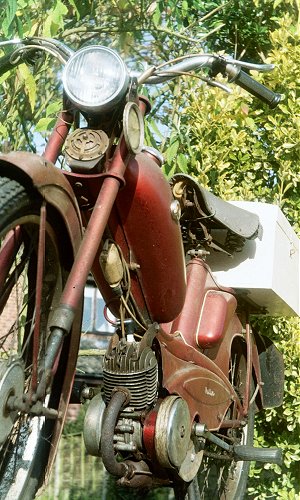
We really liked the 1.7bhp Panda of The Final Card. The bike was pretty much acquired just for the feature and came about as Martin Gates asked us to collect what he thought, from the owners description, was going to be a Phillips Gadabout Mark 4. Yes, that sounded just great, nice fast 2.7bhp AV89 motor, rear suspension, dual seat - except that when we got there, it was a Phillips Panda, and not at all what he had in mind ... so we had it!
Basically bought-in just for the article, this genuine one-owner machine had bags of personality, and ideally filled the gap of the last model from Pandamonium.
Having been moth-balled for a very long time, we ran it through the workshops to return it to running order and recovered the original registration number to make the machine a more practical proposition.
The bike proved a cracking little runner, so right on the button for the feature, but once the road test and photoshoot had been completed, though we would have loved to keep it as a staff hack, Panda sadly had to move on to make way for the next project/feature.
Posted up for sale on IceniCAM Market, the bike was sold out at a real bargain price within just a couple of days, going up to the north-east of England with its very happy new owner and leaving behind a queue of aspiring second refusals.
We've always had a soft spot for Phillips machines and the company history. Phillips was one of the five original firms that came together in 1919 to form the Tube Investments Group, and it seemed quite ironic that, some 40 years later, Phillips found themselves as one of the companies being wound down by their own creation!

They just seem to be one of those neglected brands that few people appear to be interested in. Despite being fairly well engineered and honest little bikes, prices of most Phillips models (excepting the inflation-busting P36 Motorised Cycle), have remained pretty modest, and we feel they're greatly undervalued.
As little more than a set of pictures and brief notes, this Panda Mark 3 feature has been sitting in the can for several years, and might have run sooner had not World's End intervened in early 2010, so we decided to leave another extended gap before running another Phillips feature.
It now seems so long ago that we're not sure if the Mark 3 Panda picture set was originally shot on 35mm (and we haven't done much of that for a while, so it gives some idea how long this has been sitting around), so film conversion to CD would have cost around £7.50p. With additional diesel costs tagged at just £5 for collection, The Last Card worked out a real bargain article at no more than £12.50p tops, and sponsorship credited to Gareth Thomas, EACC Nottinghamshire.